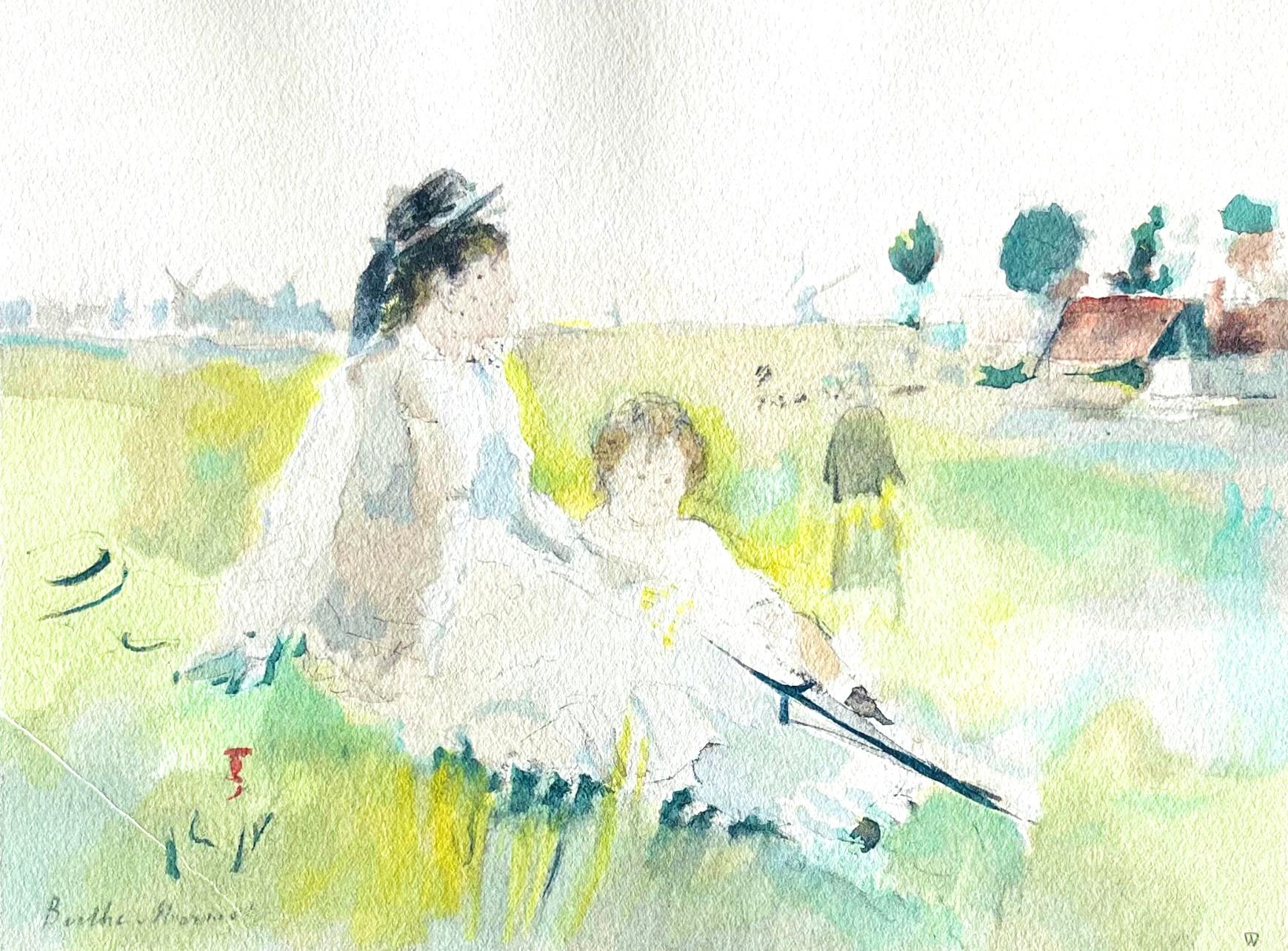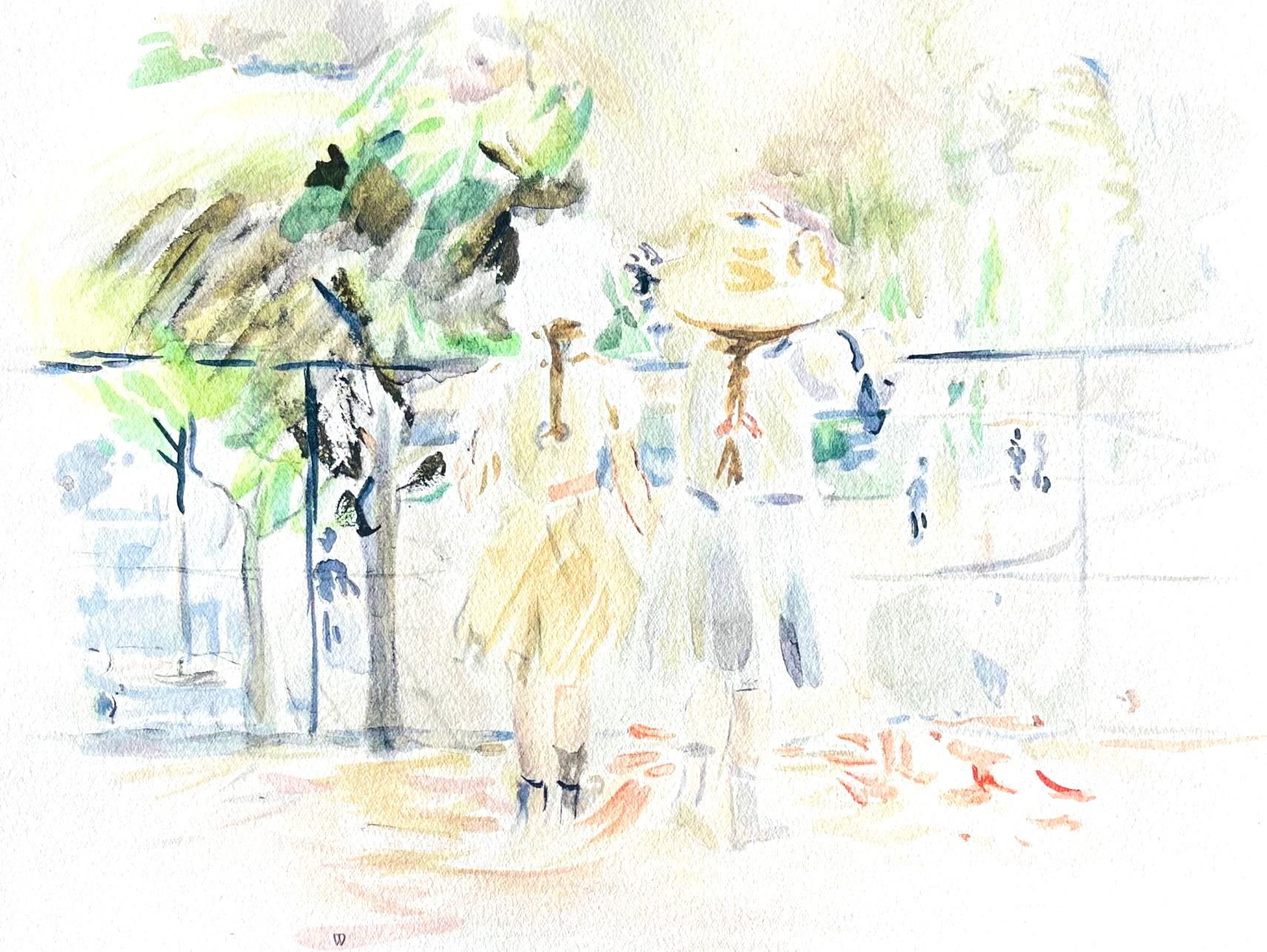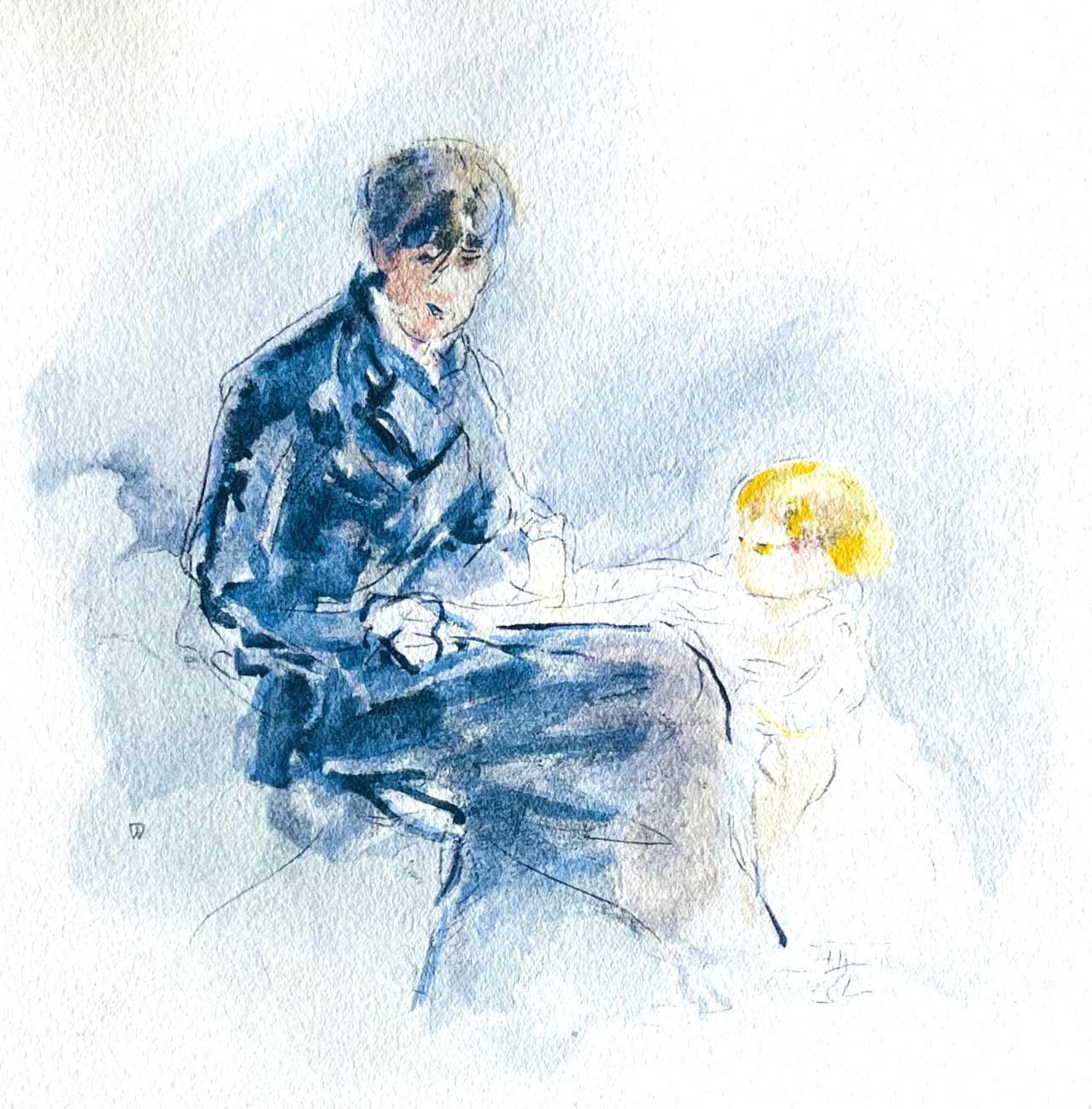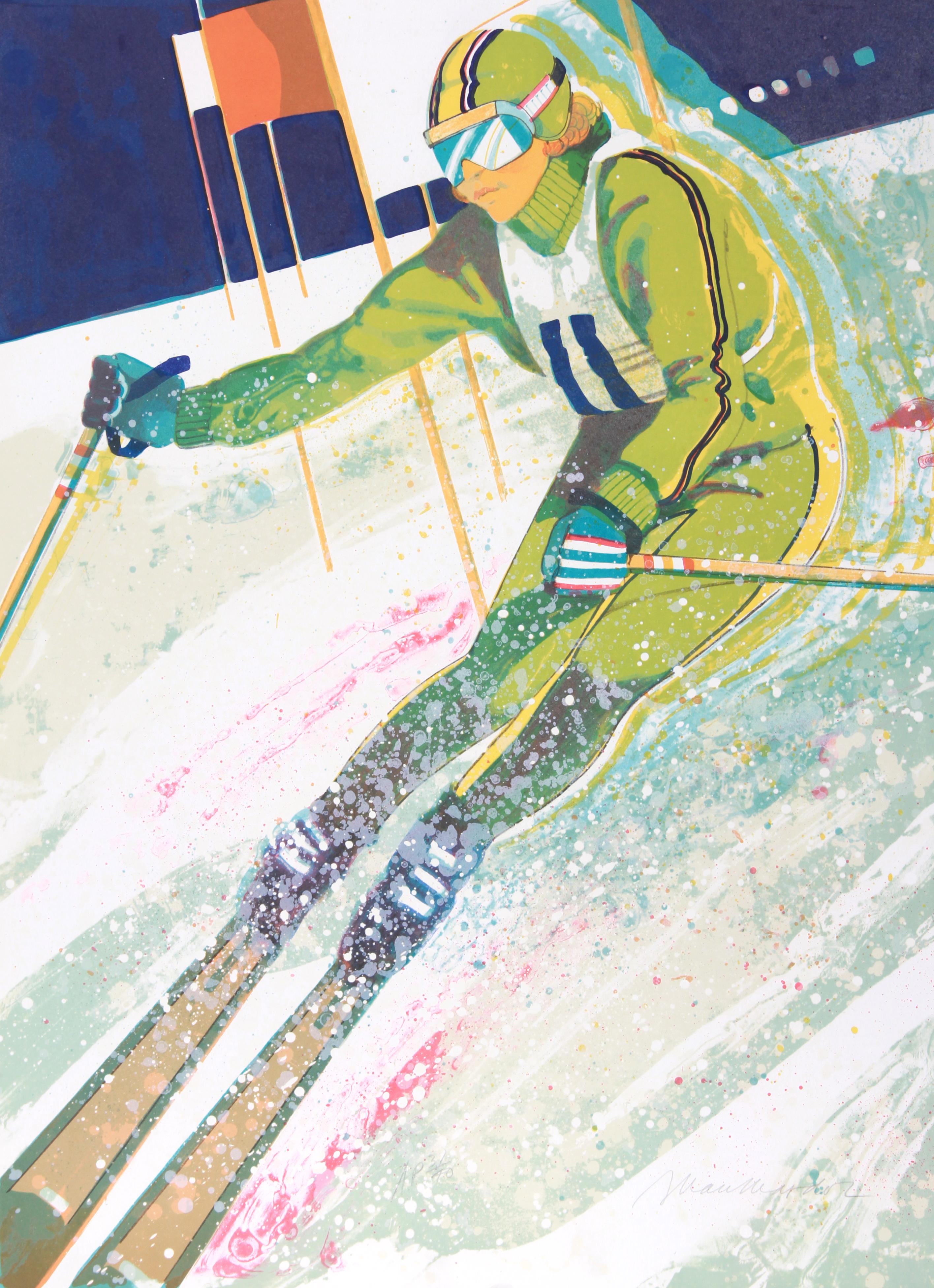Items Similar to Maurice de Vlaminck - House in Rueil - Original Lithograph
Want more images or videos?
Request additional images or videos from the seller
1 of 4
Maurice de VlaminckMaurice de Vlaminck - House in Rueil - Original Lithograph1958
1958
About the Item
Maurice de Vlaminck
Original Lithograph
Signed in the plate
1958
Title: House in Beauce
Dimensions: 22 x 27 cm
Reference: Catalogue raisonné Walterskirchen 275
Condition : Excellent
Maurice de Vlaminck (1876 - 1958)
Maurice was three years old when his family moved from Paris to Vésinet. He first pursued the same musical career as his parents, who were both musicians, leaving his home as a trained double-bass player in 1892 to move to Chatou near Versailles. After absolving his military service in Vitré Maurice Vlaminck worked as a musician until he accidentally met André Derain in 1900.
It was Derain who kindled Vlaminck's artistic ambitions. He decided to become a painter and rented an old hut in which he and Derain shared a studio. A crucial turning point in Vlaminck's artistic development was a visit to a van Gogh exhibition in Paris in the following year. In 1902 the young painter met Henri Matisse, who encouraged him to exhibit at the "Salon des Indépendents".
In 1905 Maurice Vlaminck had a group exhibition with Matisse, Derain, Friesz, Manguin and others at the "Salon d'automne". The radically new colour scheme with large areas of pure colour inspired the critic Vauxelles to refer to the artists as the "Fauves".
The lively acceptance of this new painting style is reflected in the following acquisition of Vlaminck's entire work by the art dealer Ambroise Vollard. He also arranged the artist's first one-man exhibition in 1906. A brief interest in Cubism is merely reflected in a short intermezzo of a few Cubist compositions.
Maurice Vlaminck's artistic work was interrupted for four years in 1914 when he was drafted into the war. After his release Vlaminck established a small studio in Paris where he prepared for his next exhibition. It took place in 1919 at Druet, bringing about the artist's definite break-through. The show was so successful that he was able to buy a house in Valmondois in the same year. Here, in this rural environment, Vlaminck was finally able to develop his own style as a landscape painter.
His interest in rural landscapes never ceased, even after his move to the Département Eure-et-Loire in 1925. His work was honoured in numerous international exhibitions during the 1930s.
The last years of Maurice Vlaminck's life were determined by his friendship with the Swiss doctor Sigmund Pollag, who collected the artist's graphic oeuvre and donated it to the Kunstmuseum Bern in 1970. Vlaminck wrote more than 20 books, including autobiographic texts.
- Creator:Maurice de Vlaminck (1876-1958, French)
- Creation Year:1958
- Dimensions:Height: 8.67 in (22 cm)Width: 10.63 in (27 cm)Depth: 0.04 in (1 mm)
- Medium:
- Movement & Style:
- Period:
- Condition:
- Gallery Location:Collonge Bellerive, Geneve, CH
- Reference Number:1stDibs: LU16122364983
Maurice de Vlaminck
Maurice de Vlaminck was a French painter, best known as one of the spearheads of the Fauvism movement at the start of the 20th century. His reputation rests predominantly on his landscapes, though he also produced still lifes and portraits. Born in Paris in 1876, Vlaminck had relatively little artistic training and, as a young man, dreamt of becoming a professional cyclist. A chance encounter in 1900, however, when he was nearing the end of his national service in the army, proved fateful. It was with the budding artist, André Derain, whom he met when a train they were aboard derailed. The pair lived in the small town of Chatou, a few miles along the River Seine from Paris, and they chose to complete their homeward journey from the French capital that day on foot. They struck up a friendship, and before long were sharing a studio. Derain and Vlaminck would become, alongside Henri Matisse, the driving forces behind Fauvism, the first avant-garde art movement of the 20th century. Partly inspired by the recent innovations of Paul Gauguin and Vincent van Gogh, it was characterised by aggressive brushwork, simplified forms and intense non-naturalistic colours. Its name came from the reaction of a critic in 1905 who compared the artists to fauves (‘wild beasts’). Vlaminck enjoyed painting in primary colours, and is particularly associated with scenes set in and around Chatou. Standout examples include Restaurant de la Machine à Bougival (1905) (today found in the Musée d'Orsay) and The Seine at Chatou (1906) (found in the Metropolitan Museum of Art in New York). The poet Guillaume Apollinaire hailed Vlaminck as ‘the wildest of the Fauves’. In the years immediately before the outbreak of World War I, the artist’s style shifted. His palette grew slightly more sombre, and there was a greater emphasis on solidity and a landscape's underlying structure. This revealed the influence of Paul Cezanne — the subject of a ground-breaking, posthumous retrospective in Paris in 1907. Vlaminck worked in a munitions factory during the war. His paintings after it were much darker and more realistic than those with which he had made his name. He died in 1958, aged 82.
About the Seller
4.9
Gold Seller
These expertly vetted sellers are highly rated and consistently exceed customer expectations.
Established in 2015
1stDibs seller since 2015
910 sales on 1stDibs
Typical response time: 1 hour
- ShippingRetrieving quote...Ships From: Collonge Bellerive, Geneve, Switzerland
- Return PolicyA return for this item may be initiated within 7 days of delivery.
More From This SellerView All
- Salvador Dali - Les Songes Drolatiques - Handsigned LithographBy Salvador DalíLocated in Collonge Bellerive, Geneve, CHHand-Signed Lithograph by Salvador Dali Japan Paper Title: Pantagruel's Dreams Signed in Pencil by Salvador Dali Dimensions: 76 x 56 cm Edition: EA 1973 References : Field 73-7 (p. 1...Category
1970s Surrealist Figurative Prints
MaterialsLithograph
- Marc Chagall - The Bible - Ruth at the feet of Boaz - Original LithographBy Marc ChagallLocated in Collonge Bellerive, Geneve, CHMarc Chagall, Original Lithograh depicting an instant of the Bible. Technique: Original lithograph in colours (Mourlot no. 234) On the reverse: another black and white original litho...Category
1960s Modern Figurative Prints
MaterialsLithograph
- Maurice Utrillo - Parisian Street - transfer lithographBy Maurice UtrilloLocated in Collonge Bellerive, Geneve, CHMaurice Utrillo - La Place Ravignan, Montmartre - transfer lithograph Dimensions : 13 x 10". Paper : Rives vellum. Edition : 200 copies. Printed signature, as issued 1927 From Tableaux de Paris, Emile-Paul Freres, Paris The place is now called "La Place Emile-Goudeau" Maurice Utrillo (1883 - 1955) The French painter Maurice Utrillo was born as the illegitimate son of the painter Suzanne Valladon in Paris on December 26, 1883. He was adopted by the Catalan art critic Miguel Utrillo...Category
1920s Landscape Prints
MaterialsLithograph
- Charles Martin - The Eiffel Tower - Original LithographBy Charles MartinLocated in Collonge Bellerive, Geneve, CHCharles Martin - The Eiffel Tower - Original Lithograph Dimensions : 13 x 10". Paper : Rives vellum. Edition : 225 copies. 1927 From Tableaux d...Category
1920s Modern Landscape Prints
MaterialsLithograph
- Marc Chagall - The Bible - David saved by Michal - from VERVEBy Marc ChagallLocated in Collonge Bellerive, Geneve, CHMarc Chagall, Lithograph from Verve depicting an instant of the Bible. Technique: Lithograph in colours (Mourlot no. 234) On the reverse: another black and white original lithograph (Mourlot no. 257) Year: 1960 Sizes: 35,5 x 26 cm / 14" x 10.2" (sheet) Published by: Éditions de la Revue Verve, Tériade, Paris Printed by: Atelier Mourlot, Paris Documentation / References: Mourlot, F., Chagall Lithograph [II] 1957-1962, A. Sauret, Monte Carlo 1963, nos. 234 and 257 Marc Chagall (born in 1887) Marc Chagall was born in Belarus in 1887 and developed an early interest in art. After studying painting, in 1907 he left Russia for Paris, where he lived in an artist colony on the city’s outskirts. Fusing his own personal, dreamlike imagery with hints of the fauvism and cubism popular in France at the time, Chagall created his most lasting work—including I and the Village (1911)—some of which would be featured in the Salon des Indépendants exhibitions. After returning to Vitebsk for a visit in 1914, the outbreak of WWI trapped Chagall in Russia. He returned to France in 1923 but was forced to flee the country and Nazi persecution during WWII. Finding asylum in the U.S., Chagall became involved in set and costume design before returning to France in 1948. In his later years, he experimented with new art forms and was commissioned to produce numerous large-scale works. Chagall died in St.-Paul-de-Vence in 1985. The Village Marc Chagall was born in a small Hassidic community on the outskirts of Vitebsk, Belarus, on July 7, 1887. His father was a fishmonger, and his mother ran a small sundries shop in the village. As a child, Chagall attended the Jewish elementary school, where he studied Hebrew and the Bible, before later attending the Russian public school. He began to learn the fundamentals of drawing during this time, but perhaps more importantly, he absorbed the world around him, storing away the imagery and themes that would feature largely in most of his later work. At age 19 Chagall enrolled at a private, all-Jewish art school and began his formal education in painting, studying briefly with portrait artist Yehuda Pen. However, he left the school after several months, moving to St. Petersburg in 1907 to study at the Imperial Society for the Protection of Fine Arts. The following year, he enrolled at the Svanseva School, studying with set designer Léon Bakst, whose work had been featured in Sergei Diaghilev's Ballets Russes. This early experience would prove important to Chagall’s later career as well. Despite this formal instruction, and the widespread popularity of realism in Russia at the time, Chagall was already establishing his own personal style, which featured a more dreamlike unreality and the people, places and imagery that were close to his heart. Some examples from this period are his Window Vitebsk (1908) and My Fianceé with Black Gloves (1909), which pictured Bella Rosenfeld, to whom he had recently become engaged. The Beehive Despite his romance with Bella, in 1911 an allowance from Russian parliament member and art patron Maxim Binaver enabled Chagall to move to Paris, France. After settling briefly in the Montparnasse neighborhood, Chagall moved further afield to an artist colony known as La Ruche (“The Beehive”), where he began to work side by side with abstract painters such as Amedeo Modigliani and Fernand Léger as well as the avant-garde poet Guillaume Apollinaire. At their urging, and under the influence of the wildly popular fauvism and cubism, Chagall lightened his palette and pushed his style ever further from reality. I and the Village (1911) and Homage to Apollinaire (1912) are among his early Parisian works, widely considered to be his most successful and representative period. Though his work stood stylistically apart from his cubist contemporaries, from 1912 to 1914 Chagall exhibited several paintings at the annual Salon des Indépendants exhibition, where works by the likes of Juan Gris, Marcel Duchamp and Robert Delaunay were causing a stir in the Paris art world. Chagall’s popularity began to spread beyond La Ruche, and in May 1914 he traveled to Berlin to help organize his first solo exhibition, at Der Sturm Gallery. Chagall remained in the city until the highly acclaimed show opened that June. He then returned to Vitebsk, unaware of the fateful events to come. War, Peace and Revolution In August 1914 the outbreak of World War I precluded Chagall’s plans to return to Paris. The conflict did little to stem the flow of his creative output, however, instead merely giving him direct access to the childhood scenes so essential to his work, as seen in paintings such as Jew in Green (1914) and Over Vitebsk (1914). His paintings from this period also occasionally featured images of the war’s impact on the region, as with Wounded Soldier (1914) and Marching (1915). But despite the hardships of life during wartime, this would also prove to be a joyful period for Chagall. In July 1915 he married Bella, and she gave birth to a daughter, Ida, the following year. Their appearance in works such as Birthday (1915), Bella and Ida by the Window (1917) and several of his “Lovers” paintings give a glimpse of the island of domestic bliss that was Chagall’s amidst the chaos. To avoid military service and stay with his new family, Chagall took a position as a clerk in the Ministry of War Economy in St. Petersburg. While there he began work on his autobiography and also immersed himself in the local art scene, befriending novelist Boris Pasternak, among others. He also exhibited his work in the city and soon gained considerable recognition. That notoriety would prove important in the aftermath of the 1917 Russian Revolution when he was appointed as the Commissar of Fine Arts in Vitebsk. In his new post, Chagall undertook various projects in the region, including the 1919 founding of the Academy of the Arts. Despite these endeavors, differences among his colleagues eventually disillusioned Chagall. In 1920 he relinquished his position and moved his family to Moscow, the post-revolution capital of Russia. In Moscow, Chagall was soon commissioned to create sets and costumes for various productions at the Moscow State Yiddish Theater, where he would paint a series of murals titled Introduction to the Jewish Theater as well. In 1921, Chagall also found work as a teacher at a school for war orphans. By 1922, however, Chagall found that his art had fallen out of favor, and seeking new horizons he left Russia for good. Flight After a brief stay in Berlin, where he unsuccessfully sought to recover the work exhibited at Der Sturm before the war, Chagall moved his family to Paris in September 1923. Shortly after their arrival, he was commissioned by art dealer and publisher Ambroise Vollard to produce a series of etchings for a new edition of Nikolai Gogol's 1842 novel Dead Souls. Two years later Chagall began work on an illustrated edition of Jean de la Fontaine’s Fables, and in 1930 he created etchings for an illustrated edition of the Old Testament, for which he traveled to Palestine to conduct research. Chagall’s work during this period brought him new success as an artist and enabled him to travel throughout Europe in the 1930s. He also published his autobiography, My Life (1931), and in 1933 received a retrospective at the Kunsthalle in Basel, Switzerland. But at the same time that Chagall’s popularity was spreading, so, too, was the threat of Fascism and Nazism. Singled out during the cultural "cleansing" undertaken by the Nazis in Germany, Chagall’s work was ordered removed from museums throughout the country. Several pieces were subsequently burned, and others were featured in a 1937 exhibition of “degenerate art” held in Munich. Chagall’s angst regarding these troubling events and the persecution of Jews in general can be seen in his 1938 painting White Crucifixion. With the eruption of World War II, Chagall and his family moved to the Loire region before moving farther south to Marseilles following the invasion of France. They found a more certain refuge when, in 1941, Chagall’s name was added by the director of the Museum of Modern Art (MOMA) in New York City to a list of artists and intellectuals deemed most at risk from the Nazis’ anti-Jewish campaign. Chagall and his family would be among the more than 2,000 who received visas and escaped this way. Haunted Harbors Arriving in New York City in June 1941, Chagall discovered that he was already a well-known artist there and, despite a language barrier, soon became a part of the exiled European artist community. The following year he was commissioned by choreographer Léonide Massine to design sets and costumes for the ballet Aleko, based on Alexander Pushkin’s “The Gypsies” and set to the music of Pyotr Ilyich Tchaikovsky. But even as he settled into the safety of his temporary home, Chagall’s thoughts were frequently consumed by the fate befalling the Jews of Europe and the destruction of Russia, as paintings such as The Yellow Crucifixion...Category
1960s Modern Figurative Prints
MaterialsLithograph
- L'Eglise Saint Pierre de Montmartre - PochoirBy (after) Maurice UtrilloLocated in Collonge Bellerive, Geneve, CH(after) Maurice Utrillo Title: L'Eglise Saint Pierre de Montmartre Pochoir with printed signature Edition of 550 Dimensions: 39 x 32 cm Information : This print was created for the portfolio "Le Village inspiré, Chronique de la bohème de Montmartre (1920-1950) " published by Vertex in 1950 Condition : Excellent Maurice Utrillo (1883 - 1955) The French painter Maurice Utrillo was born as the illegitimate son of the painter Suzanne Valladon in Paris on December 26, 1883. He was adopted by the Catalan art critic Miguel Utrillo...Category
1950s Modern Landscape Prints
MaterialsLithograph
You May Also Like
- Rue FurstenbergBy James Abbott McNeill WhistlerLocated in Storrs, CTRue Furstenberg. 1894. Lithograph. Way 59; Levy 90; Tedeschi, Stratis and Spink catalog 97. Only state. 8 7/8 x 6 1/4 (sheet 14 1/4 x 8 7/8). A fine ...Category
Late 19th Century Impressionist Figurative Prints
MaterialsLithograph
- Skier, Pop Art Lithograph by Alan MardonLocated in Long Island City, NYSkier Allan Mardon, Canadian (1931) Date: Circa 1980 Lithograph, signed and numbered in pencil Edition of 300 Size: 29 in. x 21 in. (73.66 cm x 53.34 cm)Category
1980s American Impressionist Figurative Prints
MaterialsLithograph
- Morisot, Le Goûter, Berthe Morisot Seize Aquarelles (after)Located in Auburn Hills, MILithograph and Stencil on vélin du Marais paper. Inscription: unsigned and unnumbered, as issued. Good condition with centerfold, as issued. Notes: From the folio, Berthe Morisot Sei...Category
1940s Impressionist Landscape Prints
MaterialsStencil, Lithograph
- Morisot, Berthe Morisot et sa fille, Berthe Morisot Seize Aquarelles (after)Located in Auburn Hills, MILithograph and Stencil on vélin du Marais paper. Inscription: unsigned and unnumbered, as issued. Good condition with centerfold, as issued. Notes: From the folio, Berthe Morisot Sei...Category
1940s Impressionist Landscape Prints
MaterialsStencil, Lithograph
- Morisot, Jeune Femme et Enfant dans l'herbe (Mme Gobillard et sa fille) (after)Located in Auburn Hills, MILithograph and Stencil on vélin du Marais paper. Inscription: unsigned and unnumbered, as issued. Good condition with centerfold, as issued. Notes: From the folio, Berthe Morisot Sei...Category
1940s Impressionist Landscape Prints
MaterialsStencil, Lithograph
- Morisot, Jeune Femme et Enfant sur un canapé (Mme Pontillon et sa fille) (after)Located in Auburn Hills, MILithograph and Stencil on vélin du Marais paper. Inscription: unsigned and unnumbered, as issued. Good condition with centerfold, as issued. Notes: From the folio, Berthe Morisot Sei...Category
1940s Impressionist Landscape Prints
MaterialsStencil, Lithograph
Recently Viewed
View AllMore Ways To Browse
Impressionist Versailles Painting
Van Gogh Lithograph Signed
Henri Manguin
Cubist Musicians Painting
Andre Beauce
Maurice Barrett
Nasa Concept Art
Palestine Walled Off Hotel
Peter Max Flower Lady
Peter Max Flower Vase
Peter Max Vase Of Flowers
Petra Jordan
St John Handbag Evening
Stark Sailboat
The Cycles Of Life Salvador Dali
Thomas Moran Etching
Twa Poster Rome
Vintage Bicyclist





